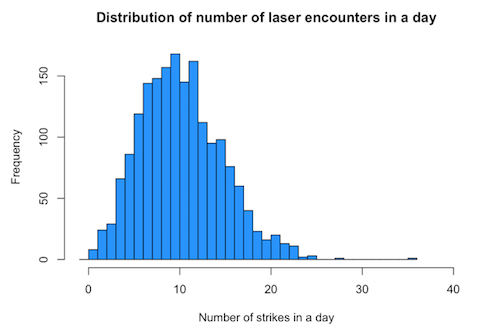Laser threats to aircraft
Background
In the US, the Federal Aviation Administration has long recognized that unauthorized laser illuminations of aircraft may have numerous hazardous effects on aircrew, including distraction, glare, afterimage, flash blindness, and, in extreme circumstances, persistent or permanent visual impairment ( FAA Advisory Circular 70-2A).
As part of their effort to deal with the hazards posed by lasers, the FAA has encouraged air crew members, air traffic controllers, and the general public to submit reports of aircraft being illuminated by lasers. The FAA has collected this kind of data since at least 2004, and in 2011 published a study (Report DOT/FAA/AM-11/7) about 2,492 laser events that occurred in the US from 2004-2008 that characterized the patterns of exposure by their likelihood of occurrence by time of day and time of year.
In December 2019, AirSafe.com produced a much more extensive study using FAA data from 2010-2018 that reviewed 22,483 FAA laser incident reports. Unlike the earlier FAA study which included reports from every type of aircraft, this study focused exclusively on large air carrier aircraft, which are airliner-type aircraft that seat from 60 to over 500 passengers. Among the key findings were the following:
- Over that nine-year span, on any given day in the United States, there is a 98.2% chance that at least one airliner had a potentially dangerous encounter with a laser beam.
- There were an average of 6.84 laser encounters per day, with as many as 33 strikes in a single day.
- While laser events occurred with great frequency on every day of the week, they were more likely to occur from late Saturday night to the predawn hours of Sunday.
- As a group, the largest metropolitan areas had a lower laser encounter rate than less populated regions of the US.
Who is this report for?
This report may be useful for the following kinds of groups:
- Anyone who wants to educate flight crews, airport authorities, law enforcement and other relevant groups as to the extent of the problem (This could be done just cutting and pasting the graphics and basic stats in the report).
- Organizations that deal with policies related to the commercial use of lasers, for example pushing for specific limits on what can be sold to the public.
- Organizations currently involved in understanding or reducing aviation safety risks associated with inappropriate use of lasers.
- Organizations, especially law enforcement agencies that, that seek to understand when and where the risk of laser strikes are highest.
What is in the report?
This report includes numerous tables, charts, and data graphics that illustrate the extent of the laser threat in the US, including the following:

Other graphical displays in the full report include the following:
- Laser encounters by day of the week
- Laser encounters by month of the year
- Heat maps showing the highest concentrations of laser strikes by time period
To see key results such as the distribution of laser strikes by time of day, day of the week, or month of the year, as well as the details for how the laser encounter risk for six major metropolitan areas were created, visit one of the following links:
The full report also includes links to the following:
- Preprocessed FAA laser data for 2010-2018 (CSV)
- R code used for supporting analyses
- R code used to generate the completed report
FAA resources
FAA laser study from 2011
Laser News, Laws, & Civil Penalties
Air Traffic Activity System (ATADS)
Report a US laser incident
Other resources
Capt. Patrick Smith on the evolution of laser concerns
Todd Curtis BBC interview on Virgin Atlantic event 14 February 2016
Todd Curtis BBC interview 24 November 2015
Todd Curtis BBC interview 1 June 2011
Todd Curtis interview 2016
http://www.airsafe.com/analyze/lasers.htm -- Revised: 2 December 2019